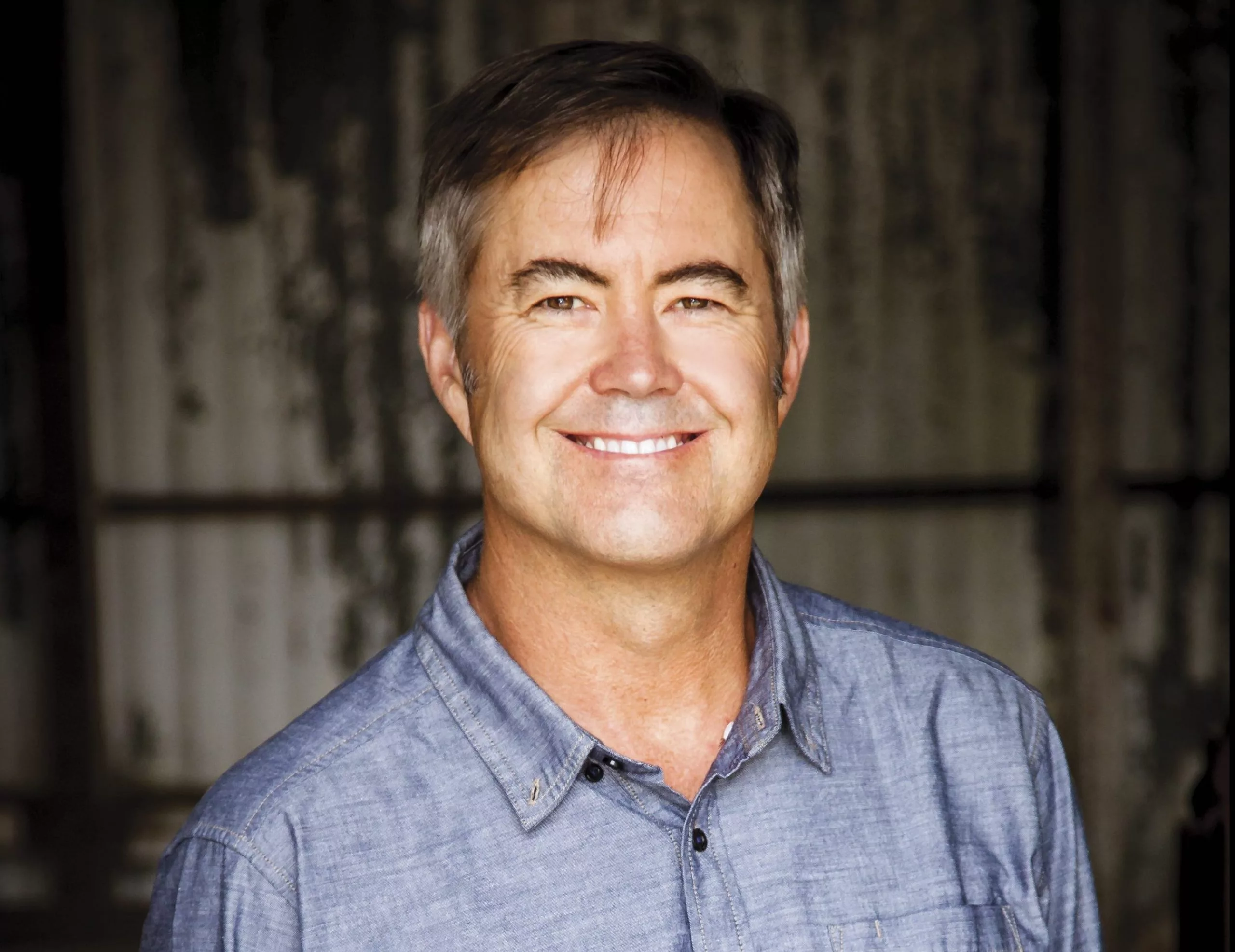Doug Freeman knows a lot about how outdoor apparel-maker Patagonia operates. He first started working there in 1985, right out of college, filing sales acknowledgments and answering the phone. Over 10 years he worked his way up in the product development team, then spent 10 years at other apparel companies. He found that he missed Patagonia’s unwavering focus on product quality, environmental factors, and social responsibility within its supply chain, so in 2007, he returned. “It was a very valuable experience to compare and contrast what I learned here in a very idealistic company versus several of those companies in a publicly traded, financially-driven environment,” he says. “Working here was a lot more fulfilling.”
These days, as COO, he spends his days helping teams set and execute the company’s vision on a short, medium, and long-term scale. “We have a great team with a very strong attention to detail, and so more times than not I find I’m not in the weeds,” he says. “The surprise for most people would be how broad the conversations become. We look at everything from IT to advanced innovation.”
We spoke with Freeman about what it’s like to actually execute on Patagonia’s mission to “Build the best product, cause no unnecessary harm, and use business to inspire and implement solutions to the environmental crisis.”
What’s a word or phrase that describes your management style and the Patagonia philosophy?
DF: “Action-oriented.” At our core, we’re activists. We fund grassroots environmental activists, and we take pride in leading by example.
From an activist standpoint, how do you take action that might be atypical?
DF: In product, it has taken the form of innovation. We want a climber, a surfer, a fly fisherman with the lightest, most breathable, most compressible product we can get them. We also innovate so that that product is built in the most responsible way we can make it, that has the least amount of harm to the environment, the lowest possible footprint. We’re operating on both those planes. So a highly breathable textile that’s also been dyed in a way that uses less water.
How do you guys reconcile having the most sustainable product with financial excellence?
DF: We have the great luxury of building the best product and pricing it out at what makes sense. It has to be extremely durable. This is product that we want people to use for decades. We don’t want to contribute to the trend where the average consumer is throwing away 65 pounds of apparel .
Our product is not inexpensive, and we hear from customers all the time as to why it’s priced the way it is. We think there’s an immense value to what we’re doing and that the product is something of an investment. If people are buying product they truly need, it makes that price, over the long run, really competitive.
As you look at the balance of this financial excellence, product excellence, and operational excellence, where are the biggest friction points? Where does it get difficult?
DF: We can find recycled or environmentally responsible materials, but often they’re not as durable as their non-responsible counterpart. We face this trade-off of the best combination of durability and environmental responsibility. If we use something that’s not going to last but it’s of recycled content, is that a better proposition?
How do you come to a conclusion on that? That sounds like a difficult question to answer.
DF: It depends on the product and the category and the case we’re working on at the time. More often than not what we try to do is to build the best product and have the environmental aspects follow. Once we’ve established its function and its relevance to the customer, we’ll work like demons on getting that into materials that are environmentally sound and responsible.
When you look at the workplace culture here at Patagonia, where does purpose fit?
DF: It’s the main driving influence for most people. They really take to heart building the best product, having product that has a low environmental footprint, and fostering good conditions within the supply chain. Those three things give folks a lot of meaning in their day-to-day work, and I’d like to think it motivates them throughout the course of their careers here.
Do you see that your ability to show and demonstrate purpose is a differentiator in being able to hire the right people?
DF: There’s no question. We’re attracting the best and brightest. People want a part of that. Especially in this climate and political atmosphere, they want to know that what they’re doing has meaning and is impacting climate change, which is the most pressing issue of our day. They don’t want to exploit people in the third world.
What does it mean to be a conscious leader?
DF: For me, it’s that we have a moral compass, a moral North Star that helps us make decisions. That we’re not looking at short-term profits, hitting the quarter…
So you’re not looking at your profits every quarter?
DF: We are. We like to keep score, and the company needs to have financial excellence so that we can give 1 percent of our revenue away to grassroots environmental activists.
What you’re saying is you’re not looking at it as the final metric of success?
DF: Absolutely. Being conscious involves a moral component where you’re improving the lives of the people in the supply chain, you’re improving the environment, you’re using the business to help others see solutions that are sustainable.
What’s it like to work for Rose Marcario?
DF: She’s on the one hand really exacting and demanding, and on the other really fun. We have a great time together. I think most people would look at a very strident, highly intelligent, dynamic woman, and not realize that that person is just about as much about having fun as the next.
When you look at your supply chain, when do you just say no to someone? How do you make decisions around that?
DF: We say no when quality is compromised or the needs of the people in the supply chain are compromised. Those are non-starters. If we see that, and we see a lack of interest in addressing those issues, we move on.
Of course, in almost every other company it starts and ends with price. That’s the first thing — how much does it cost — and then everything flows from there. Here, it starts with what we call a four-fold approach.
We don’t engage with a factory until we know four things. One, that they can build to our level of quality. Two, that they treat the environment in the way we feel it needs to be treated; the ways they manage waste and water usage and greenhouse gas emissions are consistent with our own standards. Three, from a social perspective, that they pay people a fair living wage, that their buildings are safe, that they have humane conditions to work in, that employees are not being charged to work there or forced to work overtime, that the company is hiring people of the right age. Fourth is the business parameters — capacity, lead time, minimum order quantity.
All of those factors are on the table before we start with a supplier. All four. Not just price and the business parameters, but all four. The quality person and the social and environmental director have veto power. We can have a great set of prices or all the capacity we need, but until those two people sign off, we’re not going to engage with that supplier. That’s a real distinguishing feature that we’re quite proud of.
And it’s not one person, it’s not me deciding who we work with and who we don’t, it’s a very democratic process. To your original question, when do we say no? It’s when that four-fold process takes place, and the supplier has gone through the corrective action plans if we have issues and we’re not seeing action taken. Again, that theme — the suppliers need to be activist, they need to show that they’re as big of zealots as we are for these things. And if they’re not, we move on.
What’s the hardest decision you’ve had to make? What really affected you at a heart level, and how did you make that decision?
DF: The toughest ones involve performance, whether it’s our supplier partners or the people we work with here — being fair and very honest in giving feedback. The suppliers deserve to know where we stand. They need to understand where we feel like they’re failing, and we need to be proactive in our communications with those folks. We like long-term relationships. When we get a set of circumstances that force us to move on, it’s painful. It’s painful to move away from a factory, take the business to another supplier.
You’re going to affect all of these people’s livelihoods.
DF: Exactly. We try to protect ourselves by capping the amount of business we occupy within a supplier so their dependence on Patagonia isn’t at an unhealthy level, so that helps. But each time we get to that type of decision, it’s the hardest one we make.
How do you reconcile making those tough decisions with still sleeping well at night?
DF: This four-fold approach is one of the most helpful ways, because it ensures an inclusiveness that means that we’re reflecting the company’s values in the decisions we’re making. That helps us all sleep at night, not just me. It takes a lot of pressure off any one person because it’s a collective and we’re representing all of the aspects: best product, social responsibility, the environment, and financial excellence. We need a good price, there’s no question. But we need a fair price.
If all of those four areas are firing, it helps me sleep really well. It helps Rose, it helps just about anyone here feel like it’s not all on them, that we’ve done things inclusively and collectively.






